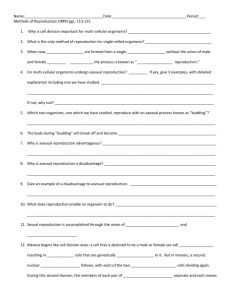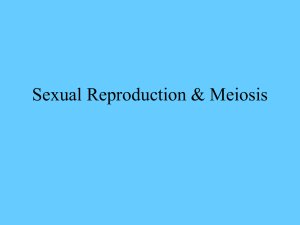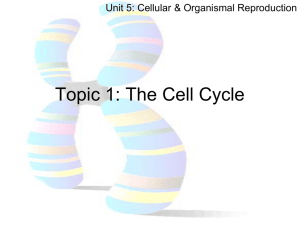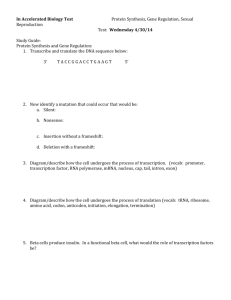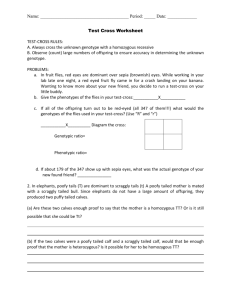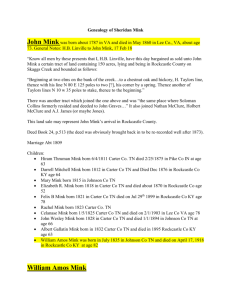1st Semester Review Name: (Required!) Date: ______ Period
advertisement
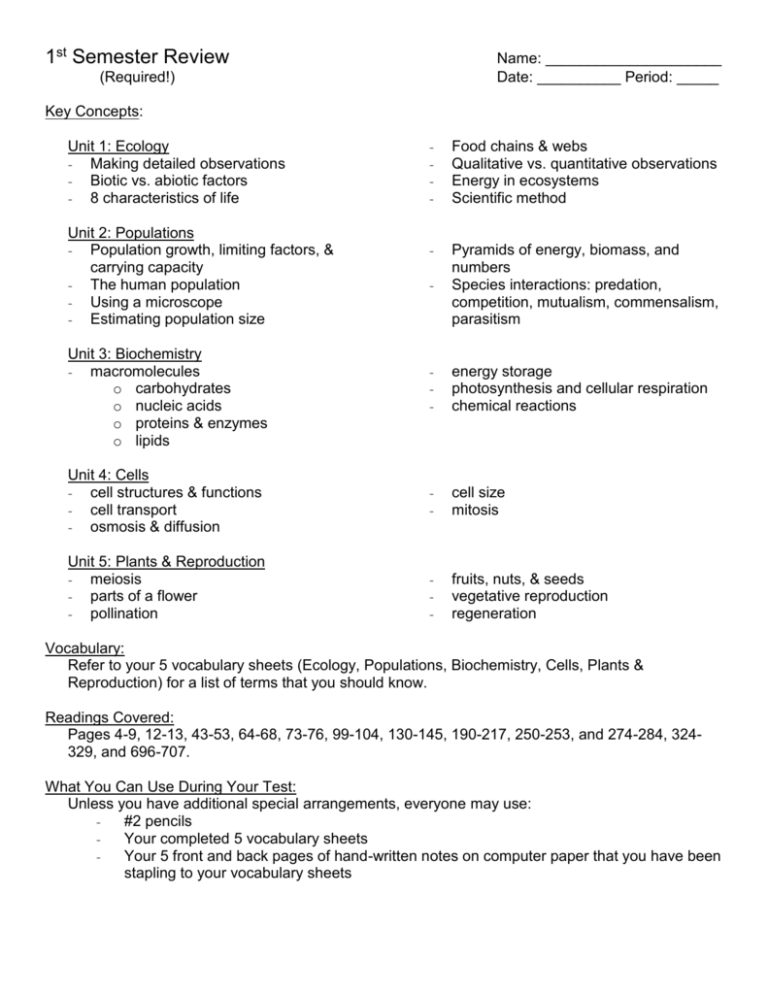
1st Semester Review Name: _____________________ Date: __________ Period: _____ (Required!) Key Concepts: Unit 1: Ecology - Making detailed observations - Biotic vs. abiotic factors - 8 characteristics of life Unit 2: Populations - Population growth, limiting factors, & carrying capacity - The human population - Using a microscope - Estimating population size Unit 3: Biochemistry - macromolecules o carbohydrates o nucleic acids o proteins & enzymes o lipids Unit 4: Cells - cell structures & functions - cell transport - osmosis & diffusion Unit 5: Plants & Reproduction - meiosis - parts of a flower - pollination - Food chains & webs Qualitative vs. quantitative observations Energy in ecosystems Scientific method - Pyramids of energy, biomass, and numbers Species interactions: predation, competition, mutualism, commensalism, parasitism - energy storage photosynthesis and cellular respiration chemical reactions - cell size mitosis - fruits, nuts, & seeds vegetative reproduction regeneration Vocabulary: Refer to your 5 vocabulary sheets (Ecology, Populations, Biochemistry, Cells, Plants & Reproduction) for a list of terms that you should know. Readings Covered: Pages 4-9, 12-13, 43-53, 64-68, 73-76, 99-104, 130-145, 190-217, 250-253, and 274-284, 324329, and 696-707. What You Can Use During Your Test: Unless you have additional special arrangements, everyone may use: #2 pencils Your completed 5 vocabulary sheets Your 5 front and back pages of hand-written notes on computer paper that you have been stapling to your vocabulary sheets Practice Questions: 1. Which of the following characteristics is NOT shared by both a horse and the grass it eats? a. Uses energy. b. Response to stimulus. c. Movement from place to place. d. Stable internal environment. 2. Which of the following is a source of energy for Earth’s living things? a. Wind energy only. b. Sunlight only. c. Wind energy and sunlight. d. Sunlight and chemical energy. 3. What are the physical, or non-living, components of an ecosystem called? a. Abiotic factors. b. Temperate conditions. c. Biotic factors. d. Antibiotic factors. 4. Which of the following statements about a scientific theory is NOT true? a. It has the same meaning in science as it does in daily life. b. It enables scientists to make accurate predictions about new situations. c. Scientific theories tie many hypotheses together. d. It is based on a large body of evidence. 5. A group of individuals that belong to a single species and that live together in a defined area is termed a(n) a. population. b. ecosystem. c. community. d. biome. 6. The movement of individuals into an area is called…. a. Immigration b. Emigration c. Population growth rate d. Population density 7. All other things being equal, the size of a population will decrease if… a. Birthrate exceeds the death rate b. Immigration rate exceeds emigration rate c. Death rate exceeds birthrate d. Birthrate equals death rate 8. Which of the following is NOT an example of a density-dependent limiting factor? a. Natural disaster b. Predator c. Competition d. Disease 9. In the presence of unlimited resources and in the absence of disease and predation, what would probably happen to a bacterial population? a. Logistic growth b. Exponential growth c. Endangerment d. Extinction 10. Which of the following best describes human population growth? a. The growth rate has remained constant over time b. Growth continues to increase at the same rate c. Growth has been exponential in the last few hundred years d. Birthrate equals deathrate 11. The way an organism makes its living, including its interactions with biotic and abiotic factors of its environment, is called the organism’s… a. Habitat b. Niche c. Lifestyle d. Biome 12. The elements or compounds that enter into a chemical reaction are called… a. products. b. catalysts c. active sites d. reactants 13. Which of the following is NOT an organic molecule found in living organisms? a. protein b. nucleic acid c. sodium chloride d. lipid 14. Which combination of particle and charge is correct? a. proton: positively charged b. electron: positively charged c. neutron: negatively charged d. electron: no charge 15. Which of the following molecules is made up of glycerol and fatty acids? a. sugars b. starches c. lipids d. nucleic acids 16. Nucleotides consist of a phosphate group, a nitrogenous base, and a… a. fatty acid. b. lipid. c. 5-carbon sugar. d. 6-carbon sugar. 17. Animal cells have all of the following EXCEPT… a. mitochondria b. chloroplasts c. a nucleus d. a cell membrane 18. The nucleus includes all of the following structures EXCEPT a. cytoplasm b. a nuclear envelope c. DNA d. a nucleolus 19. Which cell structures are sometimes found attached to the endoplasmic reticulum? a. chloroplasts b. nuclei c. mitochondria d. ribosomes 20. The difference between prokaryotic and eukaryotic cells involves the presence of… a. a nucleus b. genetic material in the form of DNA c. chloroplasts d. a cell membrane 21. Which statement is true regarding a cell’s surface area-to-volume ratio? a. As the size of a cell increases, its volume decreases b. As the size of a cell decreases, its volume increases c. Larger cells will have a greater surface area-to-volume ratio d. Smaller cells will have a greater surface area to-volume ratio 22. Which of the following is NOT an advantage of asexual reproduction? a. simple and efficient b. produces large number of offspring quickly c. increases genetic diversity d. requires one parent 23. At the beginning of cell division, a chromosome consists of two… a. centromeres b. centrioles c. chromatids d. spindles 24. The period between cell divisions is called… a. interphase b. prophase c. G3 phase d. Cytokinesis 25. In order for a cell to divide successfully, the cell must first… a. Duplicate its genetic information b. Decrease its volume c. Increase its number of chromosomes d. Decreases its number of organelles 26. The process that increases genetic diversity within a population is… a. Asexual reproduction b. Sexual reproduction c. Cell division d. Binary fission 31. Unlike mitosis, meiosis in male mammals results in the formation of… a. One haploid gamete b. Three diploid gametes c. Four diploid gametes d. Four haploid gametes 27. If a cell has 12 chromosomes, how many chromosomes will each of its daughter cells have after mitosis? a. 4 b. 6 c. 12 d. 24 32. What happens to the number of chromosomes in a cell during meiosis? a. It doubles b. It stays the same c. It halves d. It triples 28. If a cell has 46 chromosomes, how many chromosomes will each of its daughter cells have after meiosis? a. 23 b. 46 c. 92 d. none of these 29. Which of the following is NOT an advantage of asexual reproduction? a. Simple and efficient b. Produces large numbers of offspring quickly c. Increases genetic diversity d. Requires one parent 33. Pollination occurs when pollen lands on… a. The style b. The stigma c. The filament d. The anther 34. The process in which a single plant produces many offspring genetically identical to itself is… a. Sexual reproduction b. Agriculture c. Dormancy d. Vegetative reproduction 30. At the beginning of cell division, a chromosome consists of two… a. Centromeres b. Centrioles c. Chromatids d. Spindles Old Test Questions: 35. Which best defines a population? The number of: a. Biology students in high school b. Organisms in a defined area c. Types of organisms in a defined area d. Zebras in East Africa in 1982 36. Net productivity in an ecosystem is defined as: a. Energy lost by the daily activity of producers in the community b. Food energy available to consumers c. Growth of the community d. Light energy converted by producers to chemical energy 37. Which kind of energy can be directly used by all living organisms? a. Chemical energy b. Electrical energy c. Heat energy d. Light energy 38. A farmer started colonies of rats and mink hoping to feed rats to the mink and skinned mink to the remaining rats, thereby getting mink skins for nothing. Is this possible? a. Yes, because the system would be in balance b. Yes, because energy lost feeding rats to mink would be regained feeding mink to rats c. No, because second-order consumers cannot feed on each other d. No, because much of the food energy is lost as heat 39. If you were marooned on an island with only a limited amount of corn and chickens to eat, and you expected to be rescued within one month, your best strategy would be to: a. Eat the chickens, then the corn b. Eat the corn then the chickens c. Feed the corn to the chickens and eat the chickens d. Feed the corn to the chickens, eat the chickens’ eggs then eat the chickens 40. Most enzymes are: a. Carbohydrates b. Lipids c. Proteins d. Nuclei Acids 41. In which of the following cubes would the movement of materials in and out be the most efficient? a. 16 cm3 b. 8 cm3 c. 2 cm3 d. 1 cm3 42. What is the source of genetic variability? a. Crossing over (recombination) b. Mutations c. Segregation and random recombination d. All of the above 43. What is a nucleotide? a. A nitrogen base, a phosphate and a 5-carbon sugar linked together. b. The basic subunit of proteins c. The genetic code unit (codon) d. All of the above 44. The chromosomes shown in C at the bottom of the page are often called… a. analogs b. chromatids c. homologs d. tetrads 45. The process shown at the bottom of the page is called… a. mitosis b. meiosis c. binary fission d. sexual reproduction Done? Excellent! All of the answers can be found on the school website. Please log-on, grade yourself using a different color pen or pencil, and write your score below: Now look at the questions that you missed. What were they about? List 3 – 6 of the topics that you need to study the most below. All of the major concepts are listed on the first page. I really need to study: Which questions do you not understand, even after seeing the correct answer? Write down the number of a question or two that you would like Ms. Minson to go over in class. # ______ and # ______

